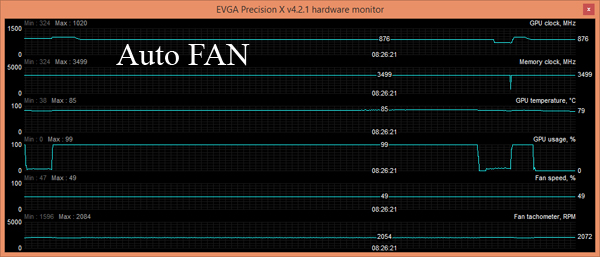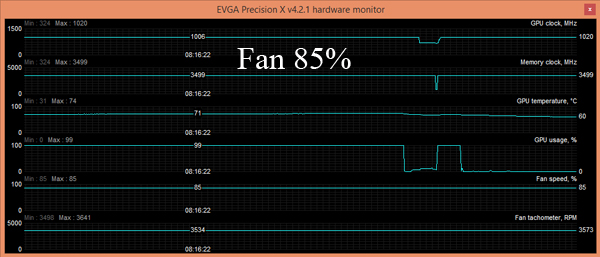Index
We applied the same methodology we used in our R9 290X tests, which means we heated up the cards before we started running game tests.
First of all we should not that we tested the R9 290X with the Über BIOS, which is clearly stated in the charts. In Über mode the R9 290X is roughly 6 to 10 percent faster than with the normal BIOS, although the gains vary depending on how hot the GPU actually is. We wanted to pit the latest NV and AMD flagships on a level playing field, so we chose the R9 290X in Über mode.
As you probably know by now, the Über BIOS makes the fan run faster, ensuring better cooling and better performance – but it also means the card ends up noisy, almost too noisy. The R9 290X in Über mode is not the loudest graphics card we ever came across, but it is the loudest card in the current generation, especially when compared to the GTX 780 Ti, which is relatively quiet. Even with the standard BIOS the R9 290X ends up a bit louder than the GTX 780 Ti.
The standard R9 290X BIOS caps the fan speed at 40% RPM, which means it doesn’t get too loud, but it also means the card can’t exploit its full potential. With the Über BIOS the fan speed can go up to 55%, ensuring higher performance and plenty of noise. We hope AMD partners will soon get the green light to roll out non-reference versions of the card with custom coolers, as they would make a lot of sense. That is another reason why we chose to test the R9 290X in Über mode, as it is simply more representative of upcoming custom cards.
However, AMD is not alone in coping with thermal issues, as the GTX 780 Ti also loses its edge when it gets too hot. But Nvidia guarantees the GPU clock will never drop below the base clock, whereas there is no such guarantee with the R9 290X. What’s more, the top 1000MHz clock for the R9 290X is only possible until the GPU heats up; our average, after running a few games, was about 850MHz.
To make things a bit more interesting we decided to check the performance of the GTX 780 Ti once the fan is revved up. We did not overclock the card, we just let the Boost engine work its magic after we accelerated the fan to 85%. At this point it was about as loud as the R9 290X with Über BIOS. We expected to get much better results of we maxed out the GPU Boost clock, but there was not much of a difference, which means you don’t have to fiddle with the card – it can just be kept in auto mode. This means that the GTX 780 Ti has a virtually ideal ratio of performance, temperature, fan speed and noise. The next two charts show why we got a little better results when we sped up the fan. It is clear that the GPU Boost clock exceeds 1000MHz in many situations and it stays there. There aren’t as many variations as in auto fan mode.
Looking at reference design we can tell that the GTX 780 Ti doesn’t reach its full thermal potential, so Nvidia AIBs could come up with plenty of OC cards and we see a lot more overclocking headroom on the GTX 780 Ti than the R9 290X.


All in all, when we take a closer look at the scores, we can safely say that the GTX 780 Ti is a card that will ensure top notch gaming. We did not have a chance to test a faster and better rounded card yet. However, the R9 290X with the Über BIOS takes a clear lead in several titles, but the GTX 780 Ti is faster in others. The R9 290X is a lot louder, but it is cheaper, too.
The AMD R9 290X was tested with the 13.11_betav8 driver, while the GTX 780/ 780 Ti / Titan were tested with the 331.70 beta drivers. New drivers and a superior custom cooler could give AMD’s card a slight advantage, but the same is more or less true of the GTX 780 Ti.
As far as performance goes, let’s look at how the GTX 780 Ti compares to the plain GTX 780. In some games the difference is very big, up to 27 percent, but in other titles, especially on lower resolutions, the difference is just 4 percent. It ends up faster than the GTX Titan as well, up to 13 percent in some cases.



